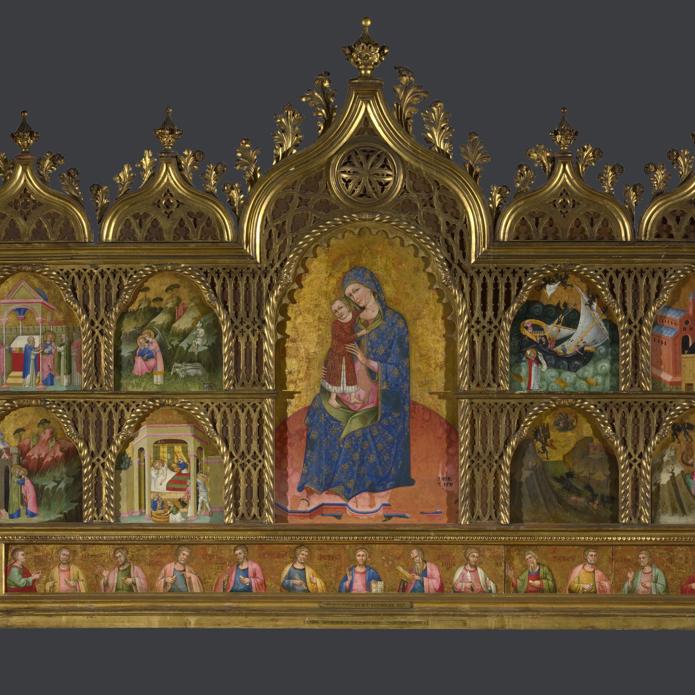Dalmatian/Venetian, 'Christ and Eight Apostles (Saints Philip to Bartholomew)', about 1400
About the work
Overview
This panel is part of the predella (lowest section) of a large altarpiece. The altarpiece’s central panel shows the Virgin and Child, and panels on either side show narrative scenes of the lives of saints.
The original predella showed Christ in the centre, surrounded by the 12 apostles, his followers; here, we see eight of them. Christ is third from the right, shown head on, his hand held high in a gesture of blessing. He holds an open book, inscribed in Latin with words from John’s Gospel: ‘I am the light of the world, the way, the truth and the life.'
The apostles hold scrolls; some also carry symbols associated with their lives or the way in which they were tortured for their Christian beliefs. Saint Peter, for example, holds keys because Christ said he would give him the keys to the kingdom of heaven. Two other small sections show the four missing apostles.
Key facts
Details
- Full title
- Christ and Eight Apostles (Saints Philip to Bartholomew)
- Artist
- Dalmatian/Venetian
- Part of the group
- Altarpiece of the Virgin Mary
- Date made
- about 1400
- Medium and support
- egg tempera on wood
- Dimensions
- 14 × 124.5 cm
- Inscription summary
- Inscribed
- Acquisition credit
- Bequeathed by H.E. Luxmoore, 1927
- Inventory number
- NG4250.6
- Location
- Not on display
- Collection
- Main Collection
- Previous owners
Provenance
Additional information
Text extracted from the ‘Provenance’ section of the catalogue entry in Dillian Gordon, ‘National Gallery Catalogues: The Italian Paintings before 1400’, London 2011; for further information, see the full catalogue entry.
Bibliography
-
1951Davies, Martin, National Gallery Catalogues: The Earlier Italian Schools, London 1951
-
1986Davies, Martin, National Gallery Catalogues: The Earlier Italian Schools, revised edn, London 1986
-
1988Gordon, Dillian, National Gallery Catalogues: The Early Italian Schools before 1400, revised edn, London 1988
-
2001
C. Baker and T. Henry, The National Gallery: Complete Illustrated Catalogue, London 2001
-
2011Gordon, Dillian, National Gallery Catalogues: The Italian Paintings before 1400, London 2011
About this record
If you know more about this painting or have spotted an error, please contact us. Please note that exhibition histories are listed from 2009 onwards. Bibliographies may not be complete; more comprehensive information is available in the National Gallery Library.
Images
About the group: Altarpiece of the Virgin Mary

Overview
This altarpiece is a unique example in the National Gallery’s collection of a work made by a late medieval artist working on both sides of the Adriatic, the sea between Italy and the Balkan coast. The picture may be one of the earliest painted representations of the Virgin of the Immaculate Conception (the Virgin being conceived without sin). This was a controversial idea in this period. It was not officially included in Catholic theology until the nineteenth century, but it was celebrated in the fifteenth century, on 8 December.
The central panel showing the Virgin and Child includes celestial bodies – the sun, moon and stars – that became associated with the Immaculate Conception. The left side panels show the story of the Virgin’s miraculous birth to a couple who could not have children; the right side panels shows two miracles of the Virgin.








